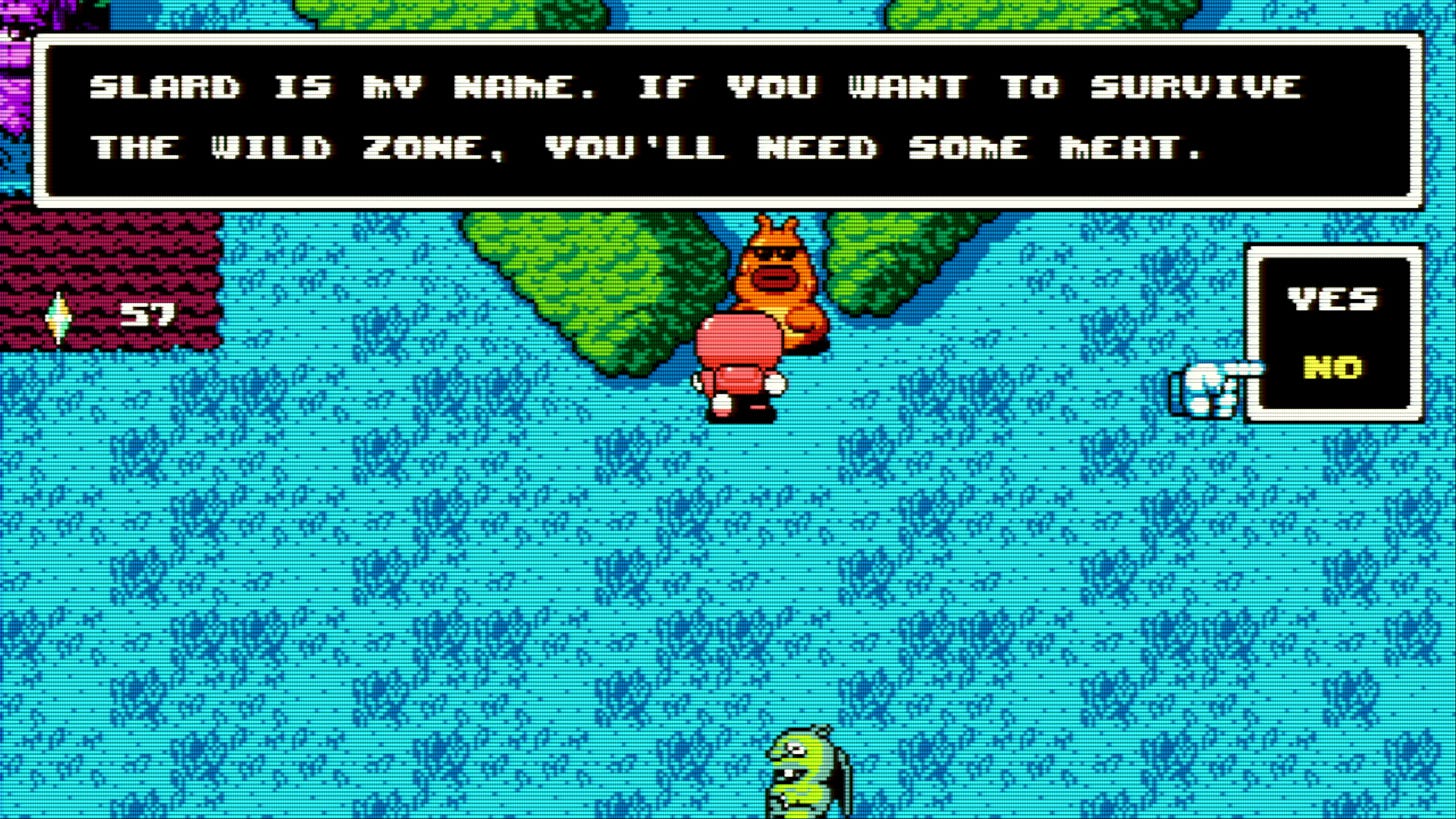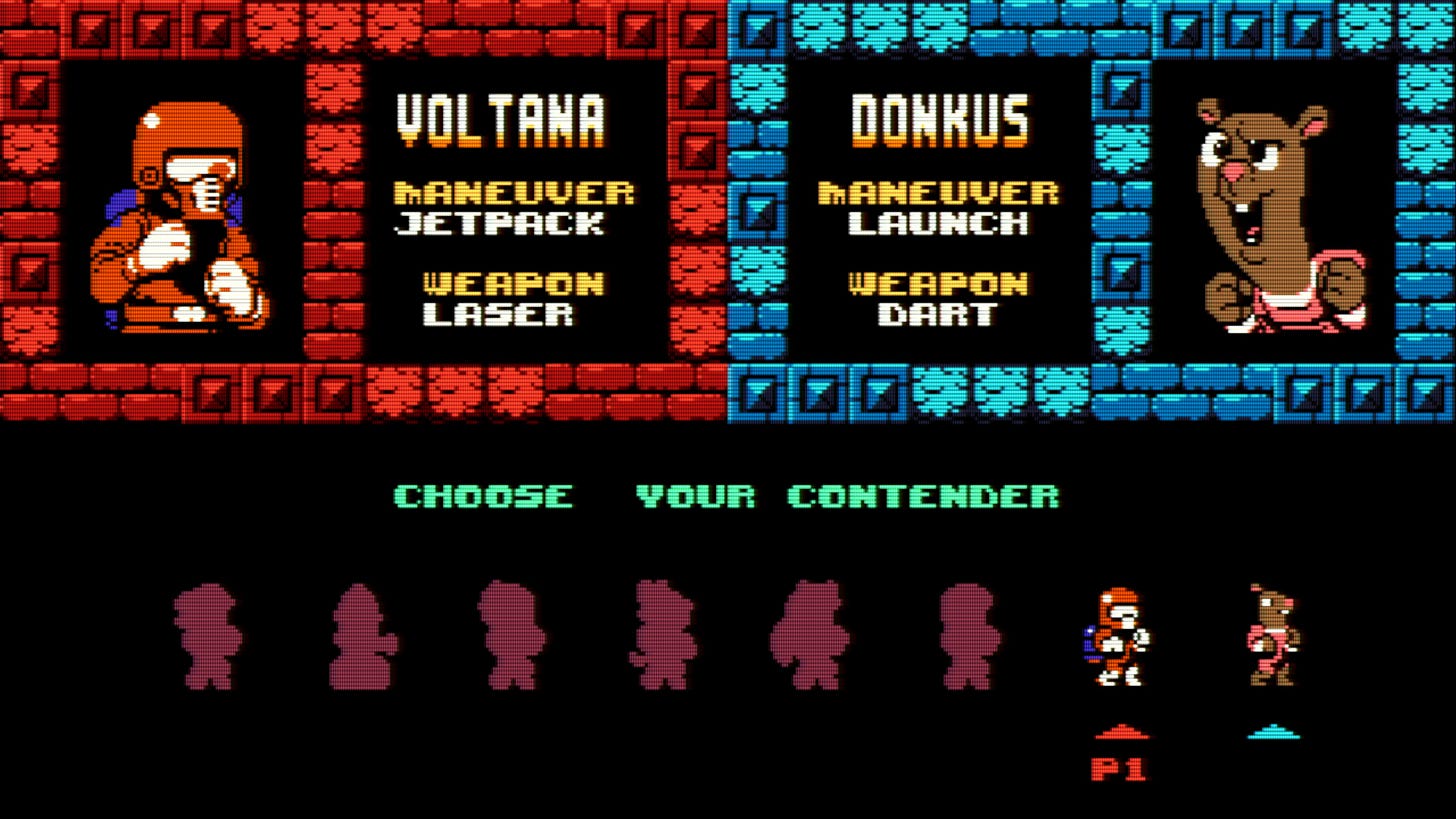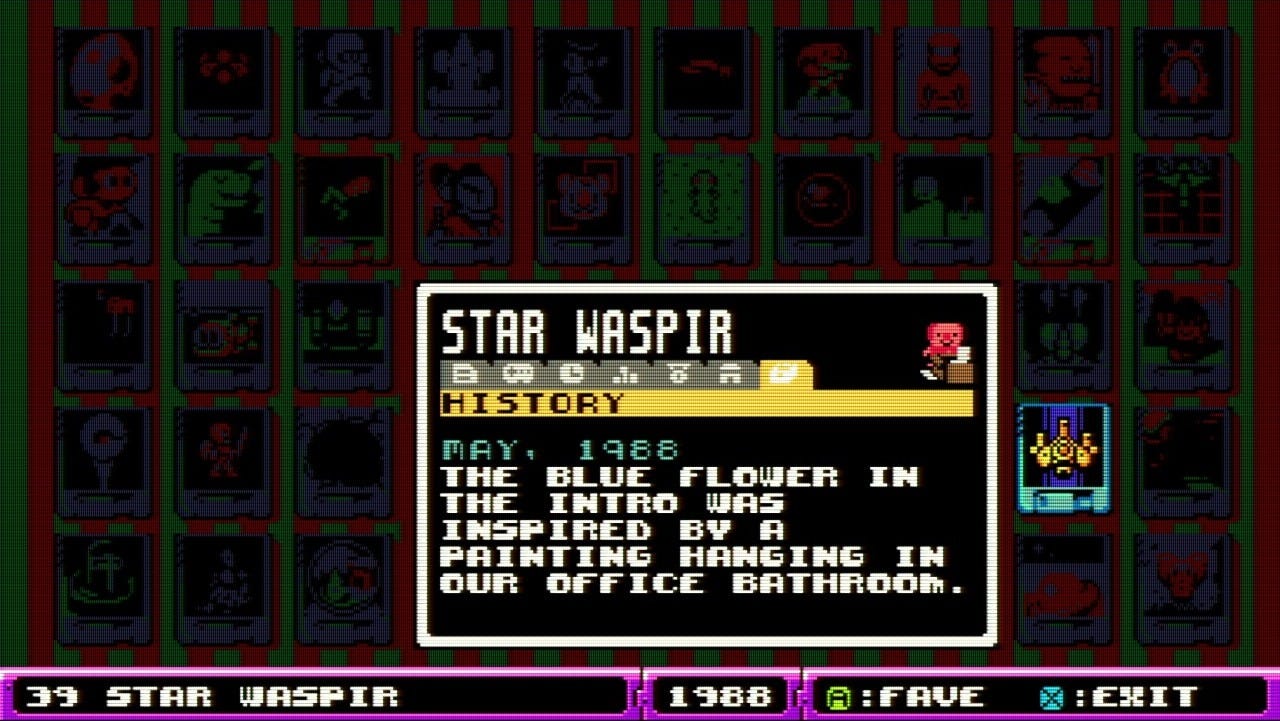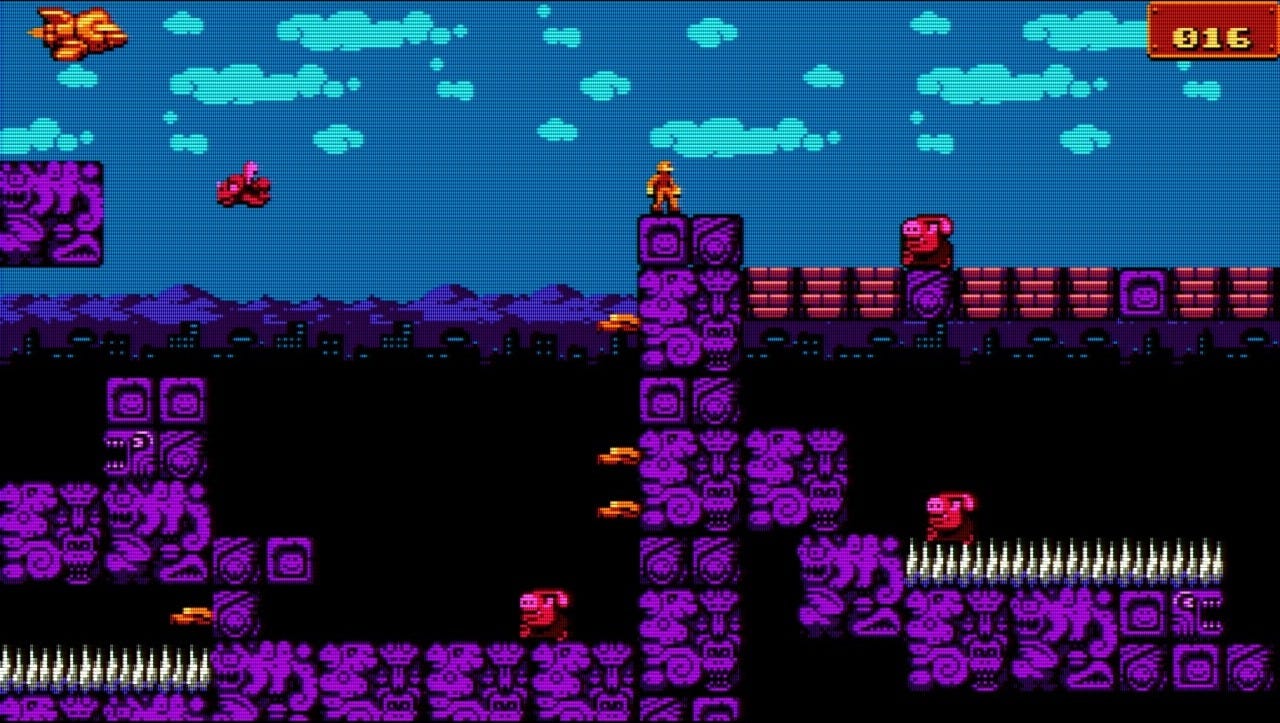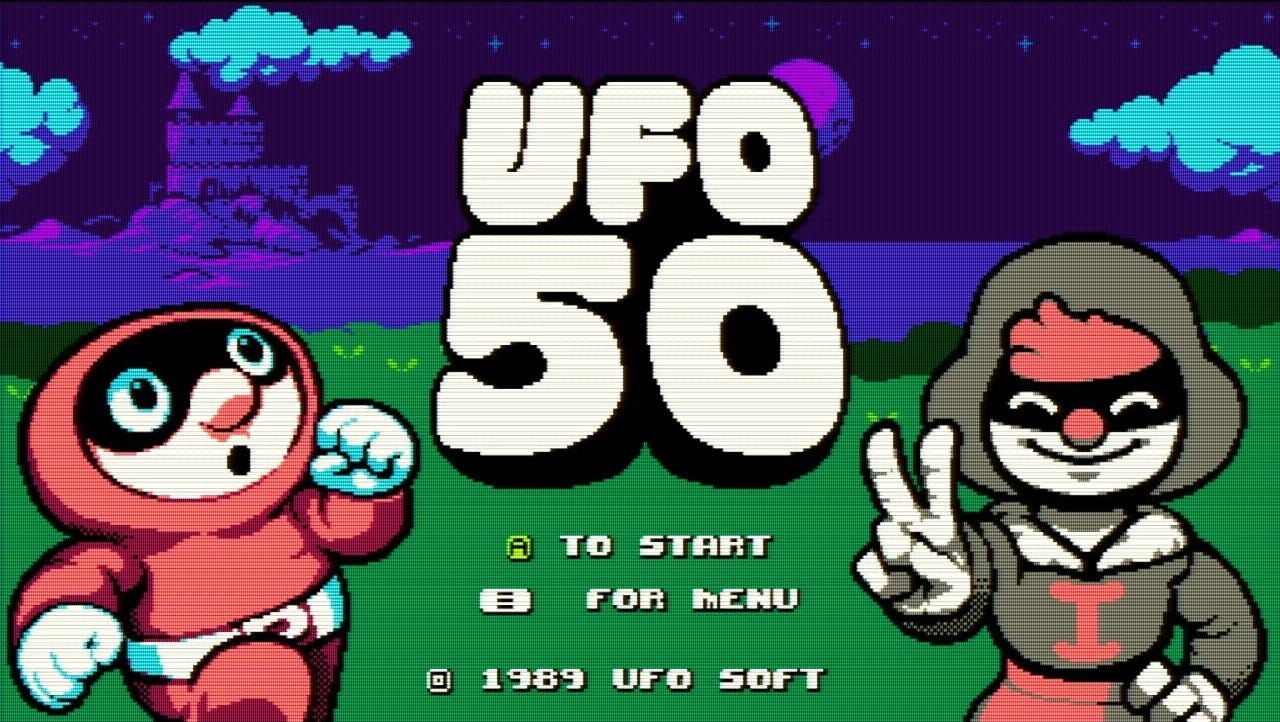UFO 50 was reviewed based on a pre-release copy provided by the publisher, Mossmouth. no money was exchanged, and all opinions are my own. thanks, Mossmouth!
there’s a lot to talk about in UFO 50. i could honestly fill a year’s worth of bug quests with discreet reviews of all 50 games crammed into this enormous indie anthology - they’re all so complete and fascinating and worthy of further analysis. and yet, the games themselves are only a tiny part of what i find so exciting about UFO 50.
so, in the interest of getting some of my thoughts out without taking on the futile task of getting all of my thoughts out, i’ll be splitting this bug quest into two parts. in part two, i’ll give you the rundown on some of my favorite games in UFO 50. if that’s all you’re interested in, feel free to skip ahead. but for now, i want to talk about the most compelling part of UFO 50: the composition of the package.
UFO 50 is presented to the player as a box of 50 cartridges, all dusty and cobweb-ridden and salvaged from a storage unit. every last one is a complete game developed by the fictional studio “UFO Soft” for the equally fictional LX, a third-generation console in the vein of the NES.
once this fiction is established, UFO 50 never breaks from it. the real-life developers behind the 50 games in the collection, a small group of indie all-stars led by Spelunky director Derek Yu and prolific board game designer Jon Perry, are given their due in the opening credits scroll and never mentioned again. instead, UFO Soft’s imaginary stable of creatives gets most of the spotlight.
UFO 50 is a bit of a mockumentary take on Digital Eclipse’s playable history games like The Making of Karateka. its 50 games are presented in “chronological order,” and each one comes with a little note left behind by an unknown, unnamed UFO Soft developer, chronicling the studio’s history from its founding members’ first solo-developed hobby games to their early commercial successes and their more mature later efforts.
the continuity of it all is, to put it lightly, an amazing accomplishment. UFO 50’s real-life development team is comprised entirely of extremely experienced and talented developers, some of whom have led generationally great games, but when you’re dropped into “Barbuta,” the first game from UFO Soft founder Thorson Petter, it seriously does feel like playing the rough and unpolished debut of a soon-to-be-accomplished genius.
it’s a difficult balancing act, for talented people who have honed their skills to effectively roleplay as talented people who are still finding their footing, but it’s even more difficult to do all that while still making an engaging and interesting game. “Barbuta” is far from the best thing in UFO 50 - it’s a metroidvania-lite action platformer with ultra-limited sound and visual effects, no music, and fairly stiff and slow movement. to be honest, it strikes me as a kind of ballsy commitment to storytelling that “Barbuta” is presented as the player’s first impression of UFO 50. but there’s a real moodiness to it all that suggests that Petter has more to show as a designer.
a few other characters pop up in the production notes on these early games - Gerry Smolski, Benedikt Chun, Chiffon Bola, and a handful of other names recur across different titles - but you’re never told too much about any of them. like the actual largely anonymous game developers of the pre-information age, UFO Soft’s staff are clearly complicated people, and like the largely uninformed players of said era, we are only really allowed to know them through the simple, abstract games they’ve released.
we know, for example, that Thorson Petter dreams of outer space, but we only know this because he happened to make a game based on a specific dream of his. this knowledge does color the rest of UFO Soft’s output, though. once you remember that Petter is drawing on something personal when he represents space in his games, you’ll start to notice just how many of UFO Soft’s games star aliens and astronauts. you’ll start to remember the humanity behind every decision.
as far as i can tell, there are no dramatic reveals in UFO 50. none of the notes mention explosive studio-threatening conflicts between key creatives or financial failures that left UFO Soft on the brink of bankruptcy. UFO 50 is more interested in the bland, revealing realities of game production.
the notes are full of anecdotes about paintings that inspired cutscenes, launch parties at local bars, new directors with new ideas, and sprites based on family members - all relatively unremarkable blips in the history of a studio, but ideas that lend so much authenticity and humanity to UFO Soft. you get the feeling that these are real games made by real people who exist beyond the screen in all the same boring and beautiful ways as everybody else.
one of my favorite pieces of storytelling in UFO 50 comes from the “Mortol” duology. “Mortol” is an early UFO Soft game that was, according to the note attached to it, “conceived by Benedikt Chun, but directed by Gerry Smolski.”
“Mortol” is a very silly slapstick platformer, one where your lives are represented by disposable soldiers who can sacrifice themselves in comedic ways to make the level a little easier. to pass an unscalable wall, for example, you might need to waste three lives by ramming soldiers into it to use their stiffened lifeless bodies as a human ladder. it’s all very silly (and surprisingly fun).
further into UFO Soft’s catalog, you’ll came across “Mortol II,” a sequel to “Mortol” that “hews more closely to Chun’s darker original vision.” in place of the faceless disposable soldiers of the original “Mortol,” “Mortol II” introduces distinct character classes, and the puzzle-platform levels of the first game are abandoned in favor of a complicated metroidvania map. it’s also not nearly as silly - it really does feel like a gritty reboot of a funny game.
this is a fantastic brick joke, one that’s set up so subtly that you might not even notice when it’s paid off, and it’s also represented by two sincerely well-designed, entertaining video games. the “Mortol” games also tell us something about Chun and Smolski as artists and as characters. not only do we get to see their respective iterations on the same concept, revealing their distinct relationships to the games they make, but we also learn that Chun cared enough about his original vision for “Mortol” to return to it years later.
UFO 50 tells me that Benedikt Chun has friends and family and dreams and favorite bars and paintings in his office. i know that all of that internality contributed to a desire to make “Mortol” the way he originally envisioned it. UFO 50’s scant few bits of writing and precise placement of its games along a timeline are so effective that i felt happy for Chun when his vision was realized.
UFO 50 isn’t just invested in the individual careers of its developers, though. this is just as much a story about the cultural and artistic evolution of UFO Soft as a team. case in point: “Campanella,” a charming level-based game about navigating dense areas in a slippery spaceship. you learn from the notes that “Campanella” was an unexpected hit for UFO Soft, but even if you weren’t told that, it wouldn’t be hard to figure out “Campanella’s” place in the studio’s history.
like “Mortol,” “Campanella” is one of the few UFO Soft games to earn a sequel. “Campanella 2” retains the slippery, imprecise movement system of its predecessor, but instead of tight levels, the spaceship is now floating through a wide-open randomly generated map. “Campanella 2” also features something conspicuously absent from the first game: visible human characters, Isabell and her brother Pilot.
these two feel specifically designed to act as UFO Soft’s mascots, and sure enough, they crop up constantly in later UFO Soft games, including “Pilot Quest,” a spinoff focused entirely on Pilot. the spaceship from the original “Campanella” even finds its way into UFO Soft’s logo, and Pilot and Isabell are hiding in plain sight on UFO 50’s title screen.
i find it difficult to express how exciting i found this. “Campanella 2” is not an actual sequel to “Campanella” - the two games were, of course, developed and released simultaneously here in the real world - but UFO 50’s actual developers were attentive and thoughtful enough that they knew UFO Soft would capitalize on the success of one game by using its sequel to introduce marketable mascots.
UFO 50 contains within its 350 megabytes a full franchise with evolving iconography that feels organic and real. the history of the “Campanella” franchise and its stars actually goes even deeper than what i’m describing here, but i have to leave you something to discover for yourself.
i’m regularly stunned by how easy it is to to chart the cultural growth of a studio that doesn’t exist, how much fun it is to track the careers and artistic inclinations of imaginary developers based on games they didn’t make.
i recognize that many of these bits of faux development mythology are just the result of actual development. obviously, some of the iterative design decisions that i attribute to UFO Soft’s fake developers are real-life iterative design decisions made by UFO 50’s actual developers. i know intellectually that when a mechanic or a character or a setting pops up more than once, it’s because the real people designing the game thought they could do more with those ideas. but i don’t think that takes away from the magic.
in fact, UFO 50’s investment in its fiction really only highlights and celebrates the actual human beings who worked on all of its many games. i have no idea how many (if any) of the notes associated with UFO Soft’s games are autobiographical. i know for a fact, though, that UFO 50’s actual developers - Derek Yu, Jon Perry, Ojiro Fumoto, Eirik Suhrke, Paul Hubans, and Tyriq Plummer - are, like their fictional counterparts, people with friends and families and dreams and favorite bars and paintings in their offices. humanity is something that we take for granted every time we play a video game, but UFO 50 celebrates it as the thing that makes games so special.
UFO 50 is infectiously in love with the idea of games as works made by people, creations motivated by emotion and history and dreams. as an anthology, it manages to represent a history that feels authentic for a studio that never was. it’s a celebration of the mundane and spectacular truths that linger in the background of every video game ever made.
oh, all 50 games are also super good. more on that in part two.






